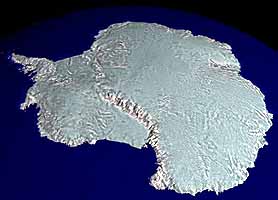| . |  |
. |
 Antarctic Sea Ice Scrubs Carbon Dioxide During Glacial Periods
Antarctic Sea Ice Scrubs Carbon Dioxide During Glacial PeriodsSan Diego - March 13, 2000 - A new study indicates that variations in Antarctic sea ice may have played a significant role in lowering atmospheric carbon dioxide (CO2) concentrations during the last ice age. This study makes progress towards unraveling the mysteries of the past climate changes, a necessary step for predicting future climate. The study by Britton Stephens, a University of Colorado researcher at the National Oceanic and Atmospheric Administration's Climate Monitoring and Diagnostics Laboratory in Boulder, Colo., (formerly of Scripps), and Ralph Keeling of Scripps Institution of Oceanography at the University of California, San Diego, appears in the March 9 issue of Nature and presents a new theory to explain why low carbon dioxide concentrations in the atmosphere are found during glacial periods. According to ice core records, every hundred thousand years or so, the earth cycles between warm periods and cold glacial periods, with Antarctic temperatures varying by about 20 degrees Fahrenheit. Records also indicate that during the glacial periods there was 30 percent less CO2 in the atmosphere. This study attempts to solve the mystery of the connection between global atmospheric CO2 concentrations and Antarctic temperatures, which seem to rise and fall together. Carbon dioxide is one of the most important greenhouse gases. While it is a naturally occurring gas, it also has been increasing in the atmosphere. Many believe this increase is due to human activities and raises concern about global warming. While algae and other microscopic plants in the oceans are constantly removing CO2 from the atmosphere as they grow and live, eventually they die and sink, returning the carbon dioxide to the deep ocean. "Thus, the amount of CO2 in the atmosphere depends on how efficiently the water from the deep ocean can return to the surface and release its extra CO2," the authors said. "Recently we have learned that deep waters primarily return to the surface around Antarctica as opposed to at low-latitudes as was previously believed." Stephens said. "Since the waters around Antarctica were mostly covered with ice during glacial periods, that could have prevented much of the CO2 in the surfacing deep waters from leaking back to the atmosphere, thereby lowering atmospheric CO2 concentrations," he added. The authors constructed a simple computer model that represents the ocean-atmosphere CO2 system and reflected the improved understanding of deep-water circulation. "When we increased the amount of sea-ice around Antarctica in the model to simulate the glacial state, the atmospheric CO2 concentration decreased by a similar amount as that observed in ice-core records," Stephens said. This result suggests that variations in Antarctic sea-ice may play a significant role in regulating atmospheric CO2 on glacial time scales. "This is the first study that shows that sea ice can have a significant effect on atmospheric carbon dioxide concentrations," said co-author Keeling. "This may be one of the keys to unraveling the origins of the major climate shifts of the past. It also opens the door to the Southern Hemisphere's control of climate. If sea ice is affecting carbon dioxide in this way, then you can imagine how many ways the Southern Hemisphere may be driving climate change throughout the world," he added. According to the authors, in order to predict future atmospheric carbon dioxide concentrations and their influence on global climate, "we need to first understand the causes of past carbon dioxide changes."
TERRADAILY.COM
|
| |||||||||
| The content herein, unless otherwise known to be public domain, are Copyright 1995-2016 - Space Media Network. All websites are published in Australia and are solely subject to Australian law and governed by Fair Use principals for news reporting and research purposes. AFP, UPI and IANS news wire stories are copyright Agence France-Presse, United Press International and Indo-Asia News Service. ESA news reports are copyright European Space Agency. All NASA sourced material is public domain. Additional copyrights may apply in whole or part to other bona fide parties. Advertising does not imply endorsement, agreement or approval of any opinions, statements or information provided by Space Media Network on any Web page published or hosted by Space Media Network. Privacy Statement All images and articles appearing on Space Media Network have been edited or digitally altered in some way. Any requests to remove copyright material will be acted upon in a timely and appropriate manner. Any attempt to extort money from Space Media Network will be ignored and reported to Australian Law Enforcement Agencies as a potential case of financial fraud involving the use of a telephonic carriage device or postal service. |